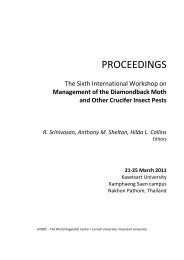Leguminous Vegetable Cultivation and Seed Production S ...
Leguminous Vegetable Cultivation and Seed Production S ...
Leguminous Vegetable Cultivation and Seed Production S ...
Create successful ePaper yourself
Turn your PDF publications into a flip-book with our unique Google optimized e-Paper software.
Description of Selected Legumes<br />
L Snap, String, or French Bean<br />
Phaseolus vidgaris likely originated from Central America. It is commonly associated with<br />
corn <strong>and</strong> squash culture in the tropical Latin American countries. It is an annual with epigeal<br />
germination.<br />
CIAT in Cali, Colombia has classified the world collection of this bean into the following<br />
four main types by growth habit: (1) dwarf determinate, (2) dwarf indeterminate, (3) prostrate<br />
indeterminate, <strong>and</strong> (4) climbing indeterminate. Beans are also classified according to use as<br />
follows: snap or string beans (for tender fresh pods); green shell beans (green shelled condition,<br />
normally bush <strong>and</strong> climbing varieties); <strong>and</strong> dry-shell or field beans (mature dry seeds);<br />
a_lLus<br />
Peas probably originated in Southwest Asia. It is a cool season crop in the subtropics <strong>and</strong><br />
also grown at higher altitudes in the tropics.<br />
2, Mungbean<br />
India or the Indo-Burmese region is the origin of mungbean. In South Asia it is one of the<br />
major leguminous vegetable crops. In Southeast Asia it is one of the three main legumes.<br />
4. <strong>Vegetable</strong> Soybean (Fdamame)<br />
Soybean originated as a domesticate in the eastern half of northern China around the 11th<br />
century BC. It was introduced from China to the USA, Japan, Korea, <strong>and</strong> South <strong>and</strong> Southeast<br />
Asian countries at different times.<br />
Large yellow or green-seeded varieties with gray hilum are preferred for use as vegetable<br />
soybeans. Based on latitudinal adaptation soybean cultivars in the USA <strong>and</strong> Canada have been<br />
classified into 13 maturity groups (MG). MG 000, 00, <strong>and</strong> 0 are early <strong>and</strong> adapted to extreme<br />
north latitudes while MG IX <strong>and</strong> X are late <strong>and</strong> adapted to tropical latitudes. However, this MG<br />
system breaks down in the tropical <strong>and</strong> subtropical latitudes.<br />
Controlled Hybridization Procedures<br />
1 . Mun . bean<br />
India has done considerable research on mungbean through their "Pulse Scheme" since<br />
1943. In 1967 an All-India coordinated Pulse Improvement Program commenced with yield <strong>and</strong><br />
disease resistance as the primary concerns. A number of varieties have been released (table 3).<br />
4
















